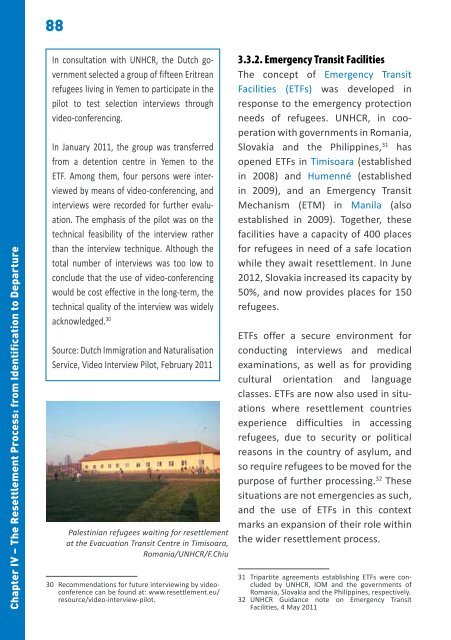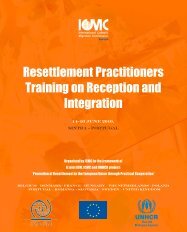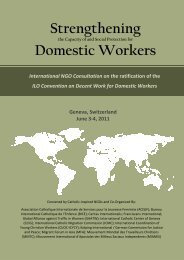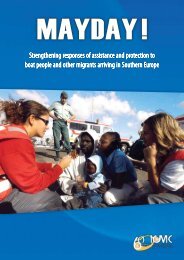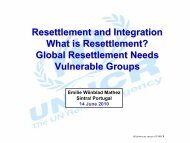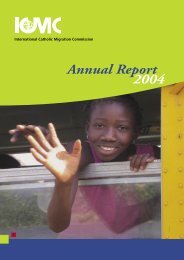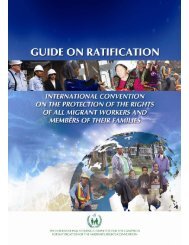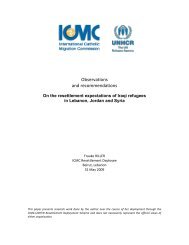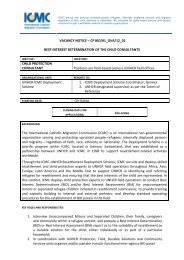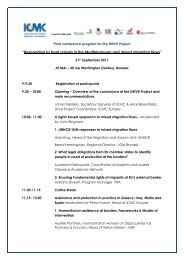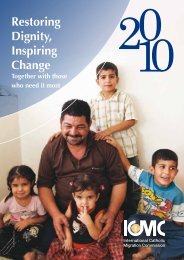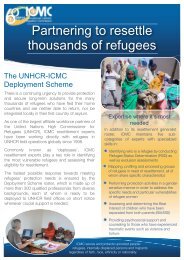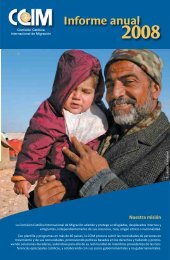ICMCEUROPE WelcometoEurope.pdf (5.89 MB)
ICMCEUROPE WelcometoEurope.pdf (5.89 MB)
ICMCEUROPE WelcometoEurope.pdf (5.89 MB)
Create successful ePaper yourself
Turn your PDF publications into a flip-book with our unique Google optimized e-Paper software.
88<br />
Chapter IV – The Resettlement Process: from Identification to Departure<br />
In consultation with UNHCR, the Dutch government<br />
selected a group of fifteen Eritrean<br />
refugees living in Yemen to participate in the<br />
pilot to test selection interviews through<br />
video-conferencing.<br />
In January 2011, the group was transferred<br />
from a detention centre in Yemen to the<br />
ETF. Among them, four persons were interviewed<br />
by means of video-conferencing, and<br />
interviews were recorded for further evaluation.<br />
The emphasis of the pilot was on the<br />
technical feasibility of the interview rather<br />
than the interview technique. Although the<br />
total number of interviews was too low to<br />
conclude that the use of video-conferencing<br />
would be cost effective in the long-term, the<br />
technical quality of the interview was widely<br />
acknowledged. 30<br />
Source: Dutch Immigration and Naturalisation<br />
Service, Video Interview Pilot, February 2011<br />
Palestinian refugees waiting for resettlement<br />
at the Evacuation Transit Centre in Timisoara,<br />
Romania/UNHCR/F.Chiu<br />
30 Recommendations for future interviewing by videoconference<br />
can be found at: www.resettlement.eu/<br />
resource/video-interview-pilot.<br />
3.3.2. Emergency Transit Facilities<br />
The concept of Emergency Transit<br />
Facilities (ETFs) was developed in<br />
response to the emergency protection<br />
needs of refugees. UNHCR, in cooperation<br />
with governments in Romania,<br />
Slovakia and the Philippines, 31 has<br />
opened ETFs in Timisoara (established<br />
in 2008) and Humenné (established<br />
in 2009), and an Emergency Transit<br />
Mechanism (ETM) in Manila (also<br />
established in 2009). Together, these<br />
facilities have a capacity of 400 places<br />
for refugees in need of a safe location<br />
while they await resettlement. In June<br />
2012, Slovakia increased its capacity by<br />
50%, and now provides places for 150<br />
refugees.<br />
ETFs offer a secure environment for<br />
conducting interviews and medical<br />
examinations, as well as for providing<br />
cultural orientation and language<br />
classes. ETFs are now also used in situations<br />
where resettlement countries<br />
experience difficulties in accessing<br />
refugees, due to security or political<br />
reasons in the country of asylum, and<br />
so require refugees to be moved for the<br />
purpose of further processing. 32 These<br />
situations are not emergencies as such,<br />
and the use of ETFs in this context<br />
marks an expansion of their role within<br />
the wider resettlement process.<br />
31 Tripartite agreements establishing ETFs were concluded<br />
by UNHCR, IOM and the governments of<br />
Romania, Slovakia and the Philippines, respectively.<br />
32 UNHCR Guidance note on Emergency Transit<br />
Facilities, 4 May 2011


